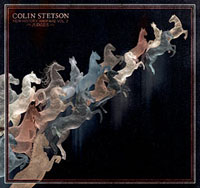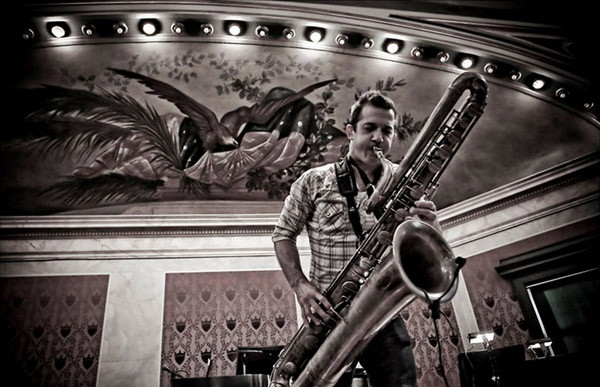 Colin Stetson: New History Warfare Vol. 2: Judges (Constellation, 2/22/11)
Colin Stetson: New History Warfare Vol. 2: Judges (Constellation, 2/22/11)
Colin Stetson: “Judges”
[audio:https://alarm-magazine.com/wp-content/uploads/2011/01/02-Judges.mp3|titles=Colin Stetson: “Judges”]Powerful, otherworldly, and beautiful, wind player Colin Stetson‘s upcoming record, New History Warfare Vol. 2: Judges, commands attention from start to finish. Largely recorded live without overdubs, Stetson exploits techniques that yield dense layers of multiphonic sound that seem impossible to have come from a single instrument. Here sounding deep and sonorous as a foghorn, there alternating between percussive popping and plaintive moans, while elsewhere emitting swirling, cyclical lines that could nearly pass for strings, Stetson pushes his horns through every timbral possibility.
With such formidable instrumental prowess, one might expect a display of flashy improvisations, yet Stetson uses his command of his instruments in service of intricate compositions, rich in atmosphere and mood, and unmoored from any genre. Moreover, the pieces function together to create a coherent whole, emotionally resonant and deeply affecting. A record that will sound arresting and fresh to even the most adventurous listeners, New History Warfare Vol. 2 (out on Feb. 22) is an early bright light among this new year’s releases and likely to resurface on many year-end lists.
Adept at bass sax, clarinet, bass clarinet, french horn, and cornet, Stetson studied music at the University of Michigan. From there, stints on both coasts resulted in work with a wide range of music luminaries, including Tom Waits, Anthony Braxton, Fred Frith, and Antibalas Afrobeat Orchestra. More recently, Stetson has startled unsuspecting rock audiences as an opener for stadium indie acts such as Arcade Fire and The National. Here he explains how this integration of influences creates his own musical worlds.
When I’ve played your music for people, the unanimous reaction has been “that’s a sax?”, which is all the more impressive given that much of it was recorded without overdubbing. Can you explain how you’re able to create such a rich and diverse range of sounds, both in terms of technique and production?
Technically, regarding the instrument, I’m just employing a lot of extended techniques that improvisers have been using for decades. The basis for most of my pieces is in circular breathing; by breathing in through the nose and continuing to breath out of the mouth, you can create these longer, uninterrupted pieces of music. After that, it’s a lot of “voicing,” or using mouth and throat placement to form chords instead of single notes, specific arpeggiated lines to move those chords into individual and distinct melodies/harmonies, and also quite a bit of actual singing through the instrument.
Having been working this out for many years, when it came time to start recording this music, I knew that a straight-up stereo recording would only take a snapshot of what was happening, and would ultimately flatten the experience. There’s no way to capture the essence of live performance in this manner, not if the idea is to recreate the same image through recording. So what I try to do is to capture every distinct and separate element I can, individually with separate and different microphones, so that this information can then be reorganized in the mixing process, and, rather than an attempt at recreating the live experience, we create an alternate version of that experience, something that is specific to the process of recording. In simpler terms, I wanted to make a record like a Haruki Murakami novel or a Terrence Malick film.
The use of extended techniques on reed instruments has become prevalent in modern improvised music, and your background includes studies with avant-garde jazz players like Roscoe Mitchell and Henry Threadgill. But your work sounds very compositional in nature and some of the repeated patterns call to mind minimalism. How did you develop this sound?
As I stated before, all of the techniques I employ are pretty much found throughout the history of avant-garde improvisation and the free-jazz scene, of which I’ve been a part musically for most of my career. I was also raised on a glut of classic rock, mostly Hendrix, the Beatles, and Queen, then later got more into metal, studied classically in university, and have played everything from folk to noise over the past many years. My inclination towards song form and thematics comes from this arc, and the technique which I must use to make it happen is based on the extended history of the instruments I play.
You’ve also done a lot of work as a sideman for rock musicians, including folks like Tom Waits and Arcade Fire. Has your playing in these contexts had any influence on your solo work?
Most definitely. Working with Tom, for example, I learned, maybe more than anything else, the importance of character and scenery within songs. You have to leave the ego out of it, and only bring those things essential to creating that scene and bringing your characters to life. This has helped me to see different musics, and my roles in them, much clearer over the years. Also, it’s caused me to think much more cinematically when composing albums. Recent work with Laurie Anderson has done much the same for me, but in different ways, and [it has] allowed me to see another example of someone creating a whole and distinct reality all of their own. It’s really remarkable and inspiring.
The record is titled New History Warfare Vol. 2: Judges. Underneath the dense fields of sound, it is generally somber and even mournful in tone, and includes meditations on the nature of war read by Laurie Anderson and a cover of a gospel blues lament by Blind Willie Johnson. What inspired the choice of thematic material?
The title New History Warfare refers to the hardship of finding and creating meaning in one’s life, or to the process of consciously taking action toward impacting one’s present place and time on a tangible level. “Judges” specifically speaks to the themes of this record — those being isolation and the pendulum swing between fear and transcendence. I find early American gospel music to embody the essence of the human condition. Through suffering, finding some path towards salvation. Joy from fear.
I suppose that all of the music in this series is my attempt at creating a personal gospel canon, not out of dogma, but rather from the human experience alone. The notion of alone-ness is amplified by the fact that this is music created solely out of one person’s efforts and experience, and as I’m learning as I write, record, and perform this music more, I become more and more isolated physically, and so do I experience these themes cyclically, it seems.
Can you describe how the compositional process works for you? How do you get ideas that form the germ of a piece and how are those developed into what we hear on the record?
My songs are mostly born of focused improvisations. I’ll normally find my way quickly to some stable pattern that will form the basis for the piece, and then I continue improvising in directions which feel right. Eventually, the thing takes shape, and I play it over and over and over until I become it to a certain degree. This process can take anywhere from a few minutes to a few weeks depending on how close I am to it in the beginning. Then, gradually, while I “wear” it, the song gets tweaked and maybe new sounds are revealed here and there, and it more or less evolves into something I consider finished. That being said, sometimes I just have an idea, and pick up the instrument, and a song comes out all shiny, new, and finished. When this happens, it is awesome.


Very fresh sounding to my jaded ear!
Dan
agree with Daniel, a classic album for time to come!